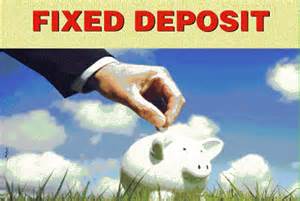Investing your money in a Fixed Deposit account is an extremely safe choice. The returns are stable and predictable.
If safety is your ultimate priority—and it well should be—you can opt to invest in a FD account. However, don’t assume that FD accounts are automatically immune to inflation and tax deductions.
They are not.
How to Calculate Fixed Deposit Interest Rates Effectively
Interest rates on Fixed Deposits vary with different banks and with the maturity period. There are many online FD calculators you can use to calculate your compound interest amount. Most Indian lenders use quarterly fixed deposit compound interest calculator.
In the online fixed deposit compound interest calculator, you just need to fill in in your FD amount, FD period, rate of interest and the compounding frequency. The calculator’s algorithm will automatically calculate the maturity amount and interest amount.
The addition of interest earned to the principal amount is called compounding. If you want to calculate the compound interest yourself, with pen and paper, the formula to calculate it is explained here:
Where
- A = Final amount that you will receive
- P = Principal amount i.e the original investment
- R = Annual interest rate in decimals
- n = Number of times the interest is compounded per year (for example, a quarterly compounding means n is 4)
- t = Number of years
Feeding your values into the equation, you can easily calculate your final amount. From this final amount, you can further calculate your interest amount using the equation:
where I = Total interest amount
Things to know Before Investing In Fixed Deposits

FDs upto Rs.1 lakh are secured by deposit insurance but if the amount is more, there’s no insurance. So, you should rather split your investment into different banks or different branches of the same bank, always keeping the amount below or equal to 1 lakh.
Consider investing in public sector banks as they provide more return on FDs compared to private banks, along with the higher safety and security.
If you’re one of those adorable Grandpas and Grandmas, you’re in luck. As senior citizens, you will be provided higher rate of returns.
Go for FD schemes where the compounding is done more frequently, to get higher interest amount.
Consider laddering your investments. You want to split your investments in multiple FD accounts with small amounts and with varying tenures. This safeguards your investment from getting stagnant in a long tenure, at a low rate of return.
Tax Deducted on Source (TDS) is deducted on FD interest incomes above Rs.10,000. You can avoid this by splitting your investment in different accounts with smaller amounts. You have to submit a declaration, if your interest income is below the exemption limit.
Withdrawing your money prematurely will lower your returns. Moreover, you may be charged with penalty for premature withdrawal.
If you invest in the name of your family members, don’t think that you won’t have to pay tax for that. The interest income is added to your income and tax is deducted accordingly.
Last but not the least, you have to consider the inflation scenario. In times of high inflation,returns on fixed deposits can be negative.
With the abundance of investment calculators online, you’ll experience no difficulty in calculating interest rates effectively. For your convenience, we have also explained the formula to manually calculate the maturity and interest amount.
Just fill in the basic details in the maturity calculator, and you will get your answer.


- business
- business loan
- chartered accountant loan
- chartered accountant loan
- Dental practice Loans
- Engineer Loan
- Engineer Loan
- Government Scheme
- GST
- Home Loan
- Insurance for Doctors
- Investment
- Loan
- loan against policy
- loan against policy
- loan against shares
- Medical equipment loan
- Medical practice
- merchant financing
- Personal Loan
- School Funding
- secured loans
- Securities
- Supply chain management
- TAN Number